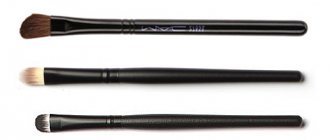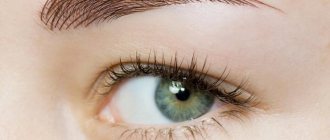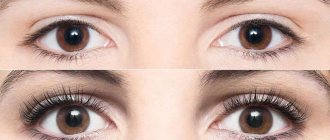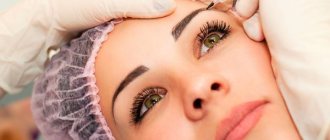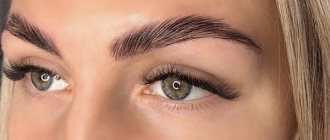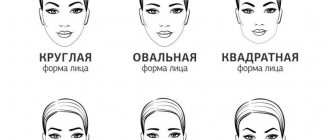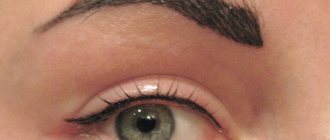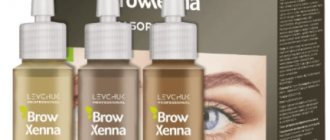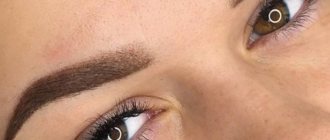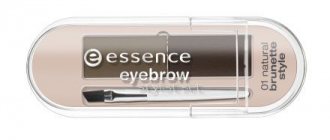Eyebrow microblading is a type of permanent makeup. The peculiarity of the method is the maximum naturalness of the result. Thanks to the art of masters, you can visually restore the natural beauty of the eyebrows and give them an aesthetic shape.
Eyebrow microblading allows you to highlight your natural beauty. The eyebrows look very natural.
The essence of microblading
The procedure has a self-explanatory name – literally translated from English it sounds like “microblade”. It is with this that the master manually makes microscopic cuts and fills them with pigment. The shade is selected depending on the client’s hair color:
- brownish-gray tones will suit blond people;
- red - brown and copper;
- for brunettes - anthracite, dark chocolate.
The pigment is taken a couple of tones darker than natural, since it brightens during the healing process and is susceptible to fading.
When working, the master uses a special handle-handle with an end in the form of a row of tightly welded manual needles. Each notch is made by hand. Their depth varies from 0.2–0.4 mm, and their width is approximately 0.18 mm.
Eyebrow healing after microblading
Naturally, many women are interested in the issue of eyebrow healing after the microblading procedure. Let's figure it out and look at the healing process with our own eyes.
You have the opportunity to see the condition of your eyebrows before and after the microblading procedure. As you can see, the effect of natural and thick eyebrows is obvious.
Let's see what our eyebrows will look like the next day after the procedure.
First day after the procedure
As you can see, nothing has actually changed. In the photo, the eyebrows are under a special cream, which cosmetologists recommend applying for healing. The consistency of the cream is very similar to Vaseline. Well, how can you go to work like this?
Second day after microblading procedure
Visually, nothing seemed to have changed. Everything is the same as yesterday. But a crust has already formed. It is impossible to see it in the photo because it is very thin, but upon palpation no pain is felt at all.
Third day after the procedure
Everything is the same as yesterday, except that you can already feel your skin starting to itch a little. It’s not visible visually, but that’s exactly what it feels like.
Fourth day
The picture hasn't changed, but the feeling has changed a little. The skin still itches a little and peeling can be observed in some places.
Fifth day
Well, here’s the result. If yesterday the eyebrows were just itching and peeling could be found in several places, today the peels are already actively coming off. Notice the uneven color in the photo? This is a sign of exfoliation. Where the crust has already come off, the color of the hairs has become lighter, and where not yet - darker. We continue to lubricate the eyebrows with cream.
Sixth day after the procedure
As you can see in the photo, the crusts still remain in the central part. Nothing. We continue to monitor the healing process and lubricate the eyebrows with cream again.
Seventh day
Hurray! No shortcuts!!! You don't have to apply the cream anymore. You can apply moisturizer in the mornings and evenings. Well, that’s probably the whole healing process.
This is what eyebrows look like 2 weeks after the microblading procedure.
Recommendations and contraindications
Experts advise undergoing a cosmetic procedure if the hairs in the eyebrow area are completely or partially absent (due to burns, scars, radiation). Micropigmentation is also suitable for people with sparse, asymmetrical eyebrows. Technology also helps to visually increase their width. But not everyone is allowed microblading. It is contraindicated for:
- impaired glucose tolerance and diabetes mellitus;
- problems with blood clotting;
- acute stage of oncology and during the year of remission;
- colds;
- blood-borne diseases such as HIV;
- serious skin ailments, the presence of wounds and pimples in the area near the eyebrows.
A professional will refuse the procedure to an expectant or nursing mother, and will also recommend waiting out the “critical days.”
Eyebrow care after manipulations
- After the permanent makeup procedure, swelling and slight swelling appear on the eyebrows.
- After a few hours, the redness will go away, but since micropigmentation is a small operation, it is worth taking care of the damage.
- It is worth wiping the sore areas with chlorhexidine for disinfection. Do this regularly, following the recommendations of the master. This is especially true during the first 24 hours, when lymph is released. The appearance of a crust will lead to the release of pigment.
- Then lubricate the damage twice a day with ointments that disinfect micro-cuts. This is "Traumel" or "Solcoseryl".
- You need to wash your face carefully, gently blotting your face, avoiding injury to the eyebrow area.
- In the second week, a crust will appear in the damaged areas, which will gradually fall off. The pigment will appear, but will not be bright.
- After about a month, you should make a correction, then the dye will lie smoothly and naturally.
- During this period, to maintain the effect, sun exposure and cosmetics should be avoided.
Advantages and disadvantages
Microblading has many benefits. The main advantage is the natural appearance after the procedure. A skilled artist will make graceful eyebrows seem natural. Other benefits include:
- almost complete absence of pain;
- minimum side effects;
- rapid healing;
- precision thanks to manual work;
- ease of subsequent correction.
The incisions are so small and shallow that swelling, if it occurs, will subside within a couple of hours. The risk of infection is very low. But still, in order to reduce it to nothing, it is necessary to follow the rules of care after the procedure.
The disadvantage is the high cost of manipulation - high-quality manual work cannot be cheap. It is also quite difficult to find a highly qualified craftsman.
Eyebrow microblading: review
Victoria: Girls, perform the microblading procedure only with a good specialist. I did exactly that, and I am very pleased with the result. Everyone around me tells me this. But unlike me, my friend decided to undergo the procedure, but did not carefully select the artist. The picture is not the best. The eyebrows have been swollen for a long time, the look is expressionless, the work is sloppy, and the healing process itself, according to her, takes a long time. I don’t know exactly what the matter is, whether the master is to blame or whether a friend did something wrong after the procedure, at the most crucial moment of healing, but the fact remains a fact.
Carrying out the microblading procedure
Those who decide to undergo micropigmentation should first find a suitable specialist. Be sure to check the availability of documents allowing you to engage in such activities, read reviews about his work. The specialist will recommend one of the microblading techniques.
Methods of manual permanent makeup
There are several microblading techniques, and not only the beauty and volume of eyebrows, but also the cost depends on the choice. The choice depends on external problems and the desired result.
What methods are popular:
| Technique | Main Feature | Result |
| Voloskovaya | Individual hairs are drawn with small strokes. | Filling bare areas and creating the perfect shape. |
| Eastern | Notches of different lengths are applied in different directions. | Creating volume and natural appearance. |
| European | Strokes of the same length are located in the same direction. | Clarity and neatness. |
| Powdery | The drawing is shaded so that the strokes are not visible. | The eyebrows appear slightly powdered. Suitable for blondes and light brown-haired women. |
| Shadow | The applied lines are deliberately made fuzzy, as if shaded. | Naturalness and volume. |
There are also modern options for microblading - 3D and 6D technologies. They allow you to create beautiful shape and volume thanks to a large number of miniature and very fine strokes.
Preparing for the session
Even if you have no contraindications to micropigmentation, preparation will be required for it to be successful. You should not adjust your eyebrow shape for two weeks before a cosmetic procedure. The master needs to see its natural shape, the direction of hair growth and its thickness.
Preparation a week before the manipulation includes refusal:
- From cigarettes and alcoholic drinks, so as not to provoke a decrease in blood clotting and avoid the appearance of ichor.
- From taking antibiotic drugs. They are able to block the action of the injected pigment.
- From tanning - natural or artificial. Exposure to ultraviolet rays hardens the skin and can lead to an unpredictable reaction to the dye.
- From excessively salty and fatty foods that cause swelling of the skin.
Just before the session, you should not drink caffeine-containing drinks - they dilate blood vessels and prevent blood from clotting.
Microblading stages
The micropigmentation procedure itself is carried out in five stages:
- Selecting a shade and creating a sketch. The master sketches a drawing of future eyebrows with a pencil, taking into account the wishes of the client, the shape of his face and facial expressions. Excess hairs outside the boundaries of the pattern are removed.
- Treatment with a disinfectant and anesthesia. Anesthesia is carried out using a special cream, which takes effect after about a quarter of an hour.
- Applying strokes. The notches are made using a manipulator; their location and length depend on the chosen technique.
- Introduction of dye. The remaining pigment is rubbed into the skin with microbrushes.
- The final stage. It includes removing the dye, treating with a disinfectant solution and applying a wound healing agent.
If you are prone to allergies, warn your cosmetologist about this. Before the session, he will conduct special tests that will show the likely reaction to the pigment.
Aftercare
The rules of care include several important prohibitions that must be observed during the recovery period. It will last at least 7 days. Not allowed:
- Combing the areas near the eyebrows and removing scabs from drying wounds - within a week they will disappear on their own.
- Use foams or scrubs for washing, peeling. Use clean water to wipe your face, being careful not to touch your eyebrows.
- Eyebrow tinting and other cosmetic procedures in this area.
- Taking a hot shower, visiting a sauna, beach, solarium.
Caring for the eyebrow area itself is quite simple. They need to be wiped with an alcohol-free disinfectant solution and lubricated with a healing cream, for example, containing panthenol.
After the rehabilitation period, experts advise making mini-compresses based on chamomile infusion and anointing the eyebrows with burdock oil.
Side effects
If the session is performed by a professional, possible unpleasant consequences are minimized. But the action of an inexperienced cosmetologist or the individual reaction of the body can lead to side effects:
- Harshness or disharmony due to an incorrectly selected shade of dye.
- Prolonged swelling and development of the inflammatory process.
- Hair loss due to damage to hair follicles.
The latter is especially unpleasant, since the lost hairs cannot be restored, and there will be bare areas on the eyebrows.
It is also possible for microscars to form if the technology is broken and the technician is inexperienced. Correctly applied strokes will heal within a week, but a deep cut will result in an unsightly scar. It will be possible to get rid of it only with the help of laser resurfacing.
Eyebrow microblading and tattooing: what's the difference?
Eyebrows made using the microblading technique are enormously different from tattooing, primarily in the visual assessment of the result. From a distance of two steps, it is difficult to understand that a woman’s eyebrows have been corrected using microblading. Before and after photos demonstrate the benefits of handmade craftsmanship. With tattooing, this effect is not always achieved.
The difference between tattooing and microblading of eyebrows lies in the difference in the techniques and equipment used. In a regular tattoo, the artist uses a single-channel needle, which introduces paint into the skin with vibrating movements of the device. The hair becomes thick and the skin is damaged. A pen with soldered needles in the amount of 7 to 21 pieces used in microblading helps to apply the hair with subtle movements of the master’s hands.
With tattooing, the eyebrow contour and shade do not look so natural, there is a high probability of a color change, for example, the dark pigment begins to turn blue, and chestnut eyebrows turn into red. With microblading, the color does not change over time, but only fades. This difference lies in the difference in coloring compositions: tattoo ink is liquid, while the microblading handpiece contains a thick, saturated pigment.
Need for correction
The full effect of microblading lasts from one to one and a half months. After this, you will need to adjust your eyebrows. The second correction will be needed 7–12 months after the first. The timing depends on the type of skin and age characteristics.
So, if the skin is prone to oiliness, correction will be required faster. The subcutaneous sebaceous secretion can erode the dye, and clear strokes begin to blur.
The younger the client, the more often her eyebrows will have to be corrected. In women of elegant age, metabolic processes are inhibited, and the dye is removed more slowly by the lymphatic fluid.
You can extend the “work” of the coloring pigment if you protect your eyebrows from direct exposure to sunlight. Sunscreen will help prevent burnout.
Pigment duration and microblading cost
Manual micropigmentation gives a lasting effect, but the duration of its effect is individual. With adjustments, beautiful eyebrows can be preserved for up to two years.
This procedure a priori cannot be cheap. If services are offered for up to 2,000 rubles, it is likely that a novice master is working, and there is a risk of side effects. The work of a professional cannot cost less than 5,000 rubles. Keep in mind that you will need to invest in adjustments later. Each procedure will cost from 2000 rubles.

